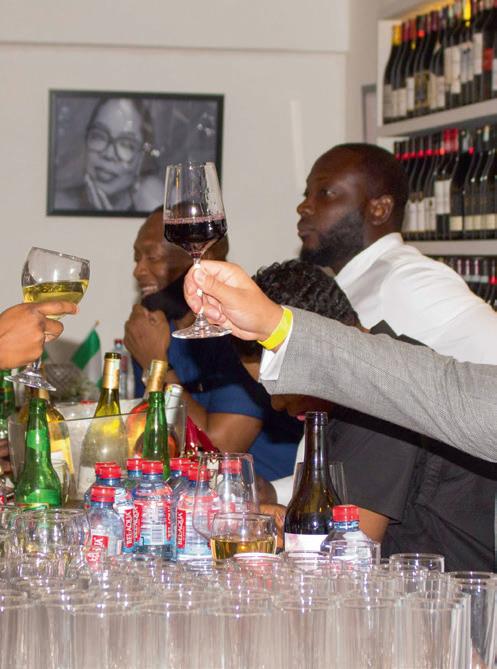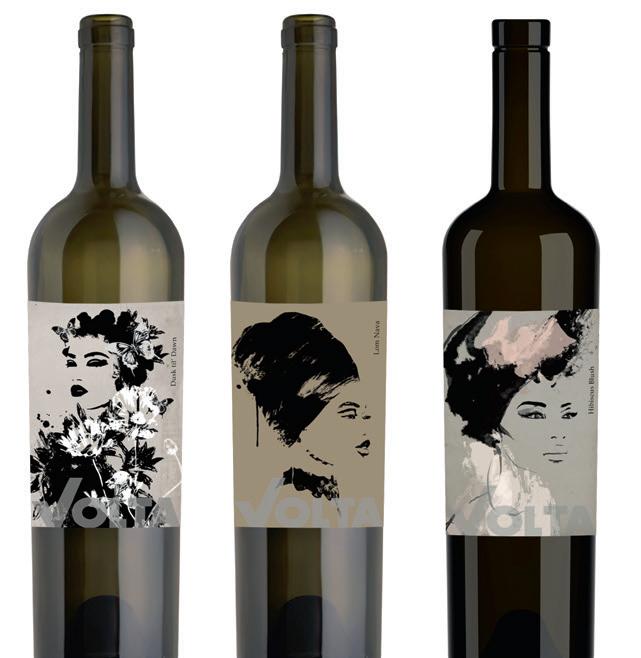
7 minute read
Wine made in Ghana
Homegrown wine from beyond the vine
Forget your grape expectations, it’s time to welcome Ghanaian wines made from cashews, cocoa and coffee. Accra’s Sai Wine Café has branded its own quartet of homegrown wines that are competing for its customers’ attention with its range of premium imports from Europe’s and South Africa’s wine-growing heartlands
Sai Wine and Champagne Cafe has done much to spread the love and appreciation of the grape in all its varieties among Accra residents with its regular wine-tasting sessions and its range of fine imported wines from old and new world wine producing companies.
But the wine café – the first of its kind in Ghana – has even been turning its customers on to wine beyond the vine. Its chief executive officer Nadia Takyiwaa-Mensah has partnered with the Volta Winery – which works from its headquarters in Ho, in the Volta Region, not with grapes, but the far more domestically plentiful cashews, cocoa and coffee beans – to release its own Made in Ghana range of wines.
Showing support
There are four wines currently in the range and Takyiwaa-Mensah talks me through the “unique taste” of each. “Dusk til’ Dawn is a cocoa white wine and tastes like a beautiful, medium bodied sauvignon blanc. Hibiscus Blush is cocoa white made red with hibiscus flowers therefore you get these subtle exotic floral notes along with a tangy citrus finish. Audacity is our cashew white and, as the name suggests, is a very bold wine. It’s initially easy on the palate but it has a heavy, aggressive finish with earthy notes. Finally, Lom Nava, which in Ewe means ‘If you love me, come’, is a rich coffee wine. “At Sai Wine Café we take pride in being a wholly owned Ghanaian company and showing patronage for all things Ghanaian. As much as we can we take advantage of local produce. So, when we came across the producer of Made in Ghana wine it was a no brainer for us. We partnered with them and created our own brand, called ‘Volta’. Our customers are super proud and super excited about the wines. They want to be part of what is Made in Ghana. We presently sell all four varietals and look forward to working with the producer in expanding on the range over the coming years.”
Showing support for her fellow Ghanaian entrepreneurs has been a trait of TakyiwaaMensah since she returned to her homeland from the UK to raise her son and set up what is now a pan-African brand management agency, Sixth Sense Manifesto. The media communications graduate had built a successful international marketing career, but returning to Ghana meant starting again. The lessons learnt on that journey were chronicled in her 2019 published book, ‘How to Get Ahead in Ghana’, a 10-step guide for Ghanaians looking to go, as the book puts it, “from average to awesome”. A follow-up to the book that targets people from the diaspora who are returning to Ghana to set up a business is soon to be released and Takyiwaa-Mensah also supports domestic enterprise as vice chair at the National Hospitality Association of Ghana – a crucial role as the industry faces the unprecedented challenges of the pandemic.
Sai Wine Café is part of that support network. It attracts Accra’s movers and shakers, who get to share ideas, hatch plans and network at regular events and experiences that include wine, tea, chocolate and even ice-cream tasting, art exhibitions, movie nights and wine and food pairing. Set up in 2015, the café’s success in turning so many Accra residents into oenophiles necessitated a recent relocation to new, larger premises in Ako-Adjei, in Osu. A three-month renovation has transformed the former nursery into a stylish spot to work, rest and play away from Accra’s bustle. The cool décor includes a wealth of framed images of inspirational figures from Africa and the diaspora.
Wines pair perfectly with African cuisine
Members share a drive to celebrate their country and have taken to the Ghanaian wines available at Sai Wine Café not just as a novelty, but, as Takyiwaa-Mensah attests, because they are comparable in quality to wines from established vineyards the world over. She believes the new range can hold its own against the pick of wines brought in from Europe, South Africa and South America that Sai Wine Café also offers its customers. “I would definitely say it is on a par with complex variation of wines which are available globally,” she says.
Takyiwaa-Mensah has also found that the homegrown wines complement the African palate but cut through the pepper and oily base. The menu at Sai Wine Café makes use of locally sourced produce and herbs grown in the café’s garden in dishes that range from vegan to fish and meat grilled on an outdoor barbecue.
“The beauty of Volta is that it can pair well with continental as well as local dishes,” she says. “But we think that is perfect for the African palate as it blends well with our carbs and proteins without it aggravating the palate or taste of your food. Sometimes wines from abroad are high in tannins and sulphites which makes it difficult to pair with a spicy dish.”


A great deal of painstaking craft and labour goes into making such premium wines. Volta Winery’s founder, Harrison Adjimah, says: “You have to have a lot of patience. Our cocoa and cashew wines are, for example, the result of careful fermentation of the pulps over one year.” Adjimah began making wine as a hobby while studying in the UK. Like many cash-strapped students, the idea of cheap alcohol appealed to him and he began home-brewing wine from strawberries, gooseberries and blackcurrants.

On return to Ghana, where he became an entrepreneurship lecturer at Ho Technical University, he started making wines from homegrown fruits. Impressed with the results, he used the growing venture to inspire his students into seeing the potential for innovation using local produce.
Adding value
Making the wine only adds value to the crop of the established smallholder cocoa and cashew farming industries in Ghana as, Adjimah says, “our cocoa wine and juice are made from the cream of the cocoa fruit and our cashew wine is made from the pulp of the fruit, both of which are usually discarded by farmers”.
While Takyiwaa-Mensah is looking to build on the relationship between Sai Wine Café and Volta Winery with more wine varieties to come, she is also looking even further into the future and entertaining the idea that Ghana could become known for its wine made from grapes in the future. “Parts of Ghana such as the Volata and Eastern Region do have the right climate. It is a very bold venture and we know a couple of people who are looking at embarking on that journey but we are yet to see anything materialise. Just like South Africa when we do get there, I am sure we shall receive global resistance but we shall persevere. In the meantime, we have alternative wine options.”

The Volta wines are available at Sai Wine Café or for retail or wholesale purchases by calling 0206 905 257.
For more information on membership, download the package from the website saighana.com or email membership@saighana.com
To see a full list of upcoming member events at the café, visit the website.
To browse and buy the Volta Winery range, which includes 3-litre cashew wine dispensers as well as cocoa fruit juice and raw chocolate nuts, call 0248772148
Wine from cocoa
Making wine from cocoa is actually nothing new. Montezuma II, King of the Aztecs of Mexico in the 16th century, is said to have drunk 50 jars of cacao wine at a ceremonial feast.
The oldest known record of cacao dates back to 1400 BC to pottery found in Honduras, in Central America, and the actual process of separating the cacao beans from the rest of the fruit of the cacao pod involves cracking the pod open and allowing the fruit around the beans to ferment, resulting in a liquid that is about 5 to 7 per cent alcohol (around the strength of beer) as well as those super tasty cocoa beans.






